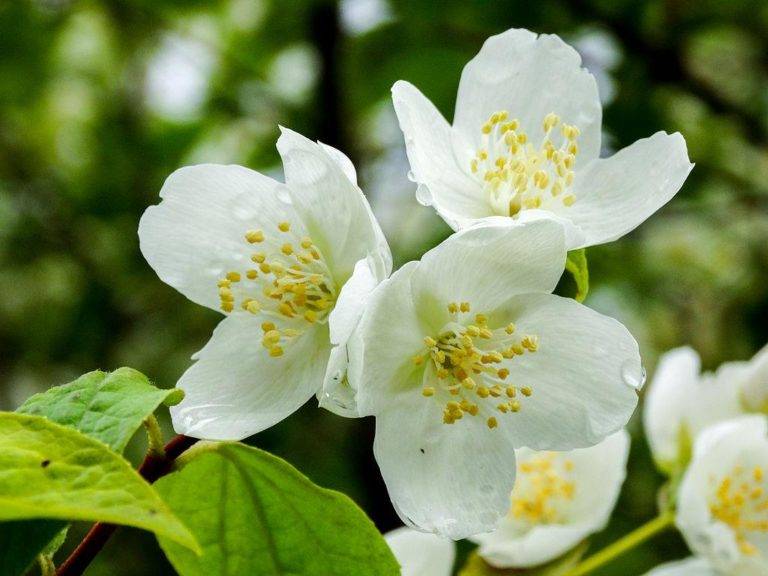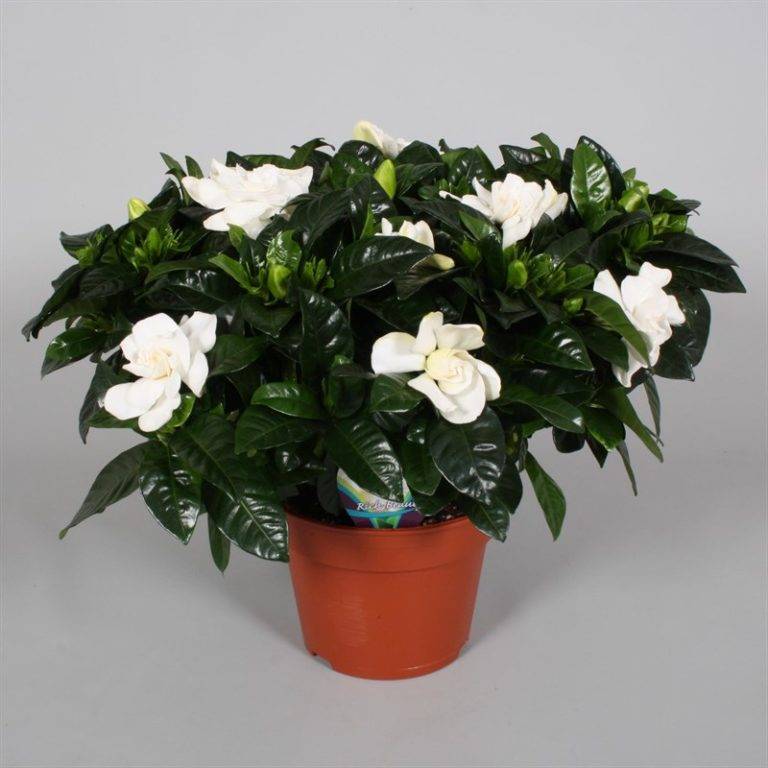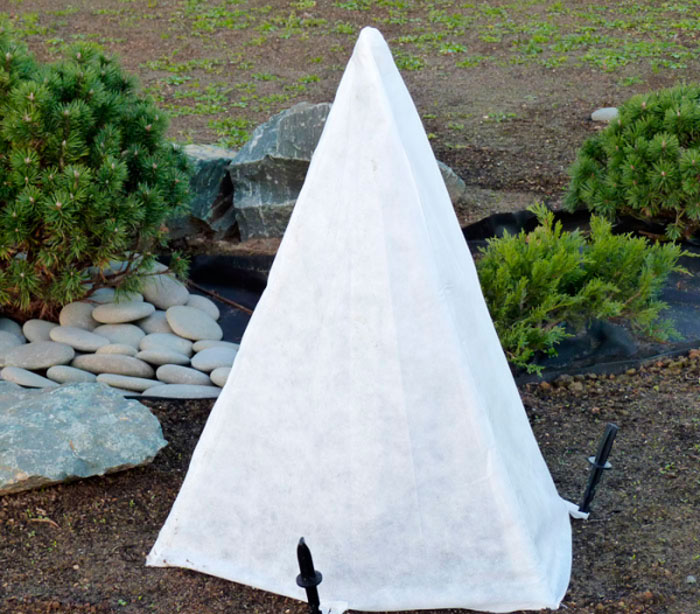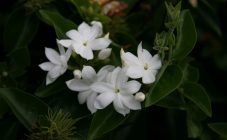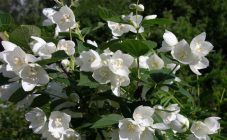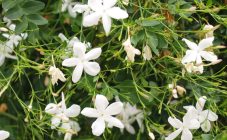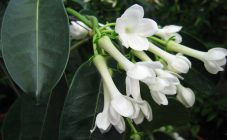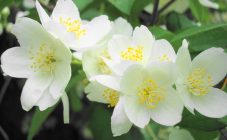Content:
Jasmine is an ornamental perennial shrub that belongs to the Olive family. This culture has up to 300 varieties. The height of the jasmine bushes ranges from 1 to 3 meters. Leaves are pinnate, simple and trifoliate. Jasmine flowers consist of 5-12 petals, yellow, white or pink. Ornamental shrubs bloom from May to July. Jasmine fruits ripen in late August - early September, they are round or oval black glossy berries. Jasmine has a delicate delicate aroma, therefore it is used in perfume compositions.
Description and characteristics of the plant
Chubushnik is often grown on personal plots. For its persistent aroma and external similarity, it is called garden jasmine, but in fact this shrub belongs to the Hortensia family.
For cultivation on garden sites more Total fit the following varieties:
- Common jasmine (crown) is a shrub up to 3 meters high with white or cream flowers that have a strong sugary aroma;
- Fluffy jasmine is a large shrub or tree 4 meters high with cream flowers. Light airy aroma;
- Small-leaved jasmine is widely used in landscape design. It is placed along paths, verandas and gates are decorated. It is a compact shrub, no more than 1 meter in height, double and semi-double flowers.
Landing
Jasmine shrub planting and care have their own characteristics. Landing in open ground is best done in spring. Jasmine has a wonderful property - adaptability to any climatic conditions, but drafts are an unfavorable factor, the bush loses its decorative appearance. To get a beautiful, powerful, abundantly flowering bush, you need to choose a well-lit area, protected from drafts. It is best to plant the jasmine next to a hydrangea or spirea.
Planting recommendations:
- Jasmine does not tolerate excess moisture, so for planting it is worth choosing an elevated place on the site. Additionally, you need to prepare a drainage layer 20 cm thick, consisting of sand and gravel;
- Before planting, the soil must be well prepared, it must be very soft. To do this, you need to dig it up well, remove all the weeds,break the lumps.
- Next, you should make a hole 50 cm deep, lay out the drainage, then sprinkle with 30 g of nitrophoska;
- Place the bush in a hole and cover it with soil; the root collar should not be buried more than 3 cm. The earth must be well tamped and watered.
Care
There are several conditions that must be observed in order for jasmine to bloom profusely and retain its decorative effect:
- Weekly weeding and loosening of the soil;
- Systematic application of mineral and organic fertilizers. Top dressing is applied for plants older than one year. Slurry diluted with water in a ratio of 1:10 is used as an organic fertilizer. Under each bush, you need to apply about 20 liters of this fertilizer. Frequency - once a month. Mineral dressing consists of a solution of 10 g of urea, 15 g of potassium sulfate and 30 g of superphosphate per 10 liters of water. This is enough to fertilize two plants;
- Sufficient watering. Jasmine does not tolerate drought well, the leaves turn yellow and wither. Therefore, in especially hot periods, under each bush, you need to pour 30 liters of water every 2 days;
- Pruning. Abundant flowering ensures timely removal of empty branches.Very long branches should be removed completely, medium ones should be cut in half. It is imperative to do formative pruning in April - May. To rejuvenate the bush, you need to cut the main 4-5 trunks to 40 cm, the rest at ground level. The frequency of sanitary pruning is once every 7 years. Every year it is necessary to inspect the bush for the presence of old and diseased branches and carry out their pruning;
- Removing faded flowers.
Reproduction
- Reproduction by layering. In early spring, young shoots are bent to the ground and covered with soil. After the appearance of new branches, the layers are spudded, and in the fall it is separated;
- Propagation by cuttings. In June, it is best to prepare planting material. You need to take a young shoot 10 cm long, cut it obliquely under the lower bud. Before planting, the cutting should be kept in a solution that stimulates root formation for 1 day. Cuttings should be planted in a peat-sand mixture (1: 1 ratio), planting depth is up to 3 cm, the lower leaves should not be underground. Within 14 days, the cuttings must be sprayed and shaded from direct sunlight;
- Reproduction by dividing the bush is not the most popular method; it is used if it is necessary to transplant jasmine. The procedure is best done in October. The land is watered abundantly and the bush is carefully removed. The roots are washed well, then the bush is divided into parts.
Jasmine can also be grown at home.
Prevention and treatment of diseases
Jasmine is a plant that can adapt to any conditions and has a high ability to recover, so it is practically not exposed to diseases, pests also do not like this shrub. Sometimes in unfavorable conditions for the cultivation of shrub jasmine, a spider mite or aphid appears, which destroy the leaves. Also, the bushes can be attacked by a soft false shield, a weevil and a mealybug. In these cases, the use of insecticides will be helpful. You can also use folk methods, in the fight against pests, a solution of laundry soap does an excellent job.
Preparing for winter
Only young plants up to 4 years old need preparation for winter, since the tops can freeze in severe frosts. In the spring, after carrying out the forming pruning, the bushes quickly recover. Adult plants are highly frost-resistant and do not need additional shelter. When the young shrub has faded, it needs to be covered with special material or straw. Jasmine roots must also be protected from freezing. To do this, in the fall, you should dig up the soil around the trunk, do mulching. For mulching, you need to take peat, stale manure, compost or dry leaves and pour a layer of 15-20 cm.
Jasmine is an unpretentious plant. There is no need to create individual conditions for him and devote a lot of time to caring. It is worth paying attention to cutting off unnecessary branches, and the plant will delight the owner with abundant flowering and serve as a decoration for the summer cottage.
